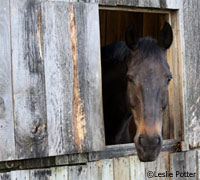 For the past three years, animal health company Merial has hosted gastroscopy events across the country, and the results consistently show stomach ulcers are a threat to horses of all breeds and disciplines. From 2008 through 2010, veterinarians scoped 3,354 horses, with more than 58 percent of them identified with some grade of stomach ulcer. In 2010 alone, 644 horses of varying disciplines from 30 states had some ulceration as identified by gastroscopy.
For the past three years, animal health company Merial has hosted gastroscopy events across the country, and the results consistently show stomach ulcers are a threat to horses of all breeds and disciplines. From 2008 through 2010, veterinarians scoped 3,354 horses, with more than 58 percent of them identified with some grade of stomach ulcer. In 2010 alone, 644 horses of varying disciplines from 30 states had some ulceration as identified by gastroscopy.
- 328 horses, 28 percent, with Grade 1 ulcers (mild ulcers with small lesions or damaged tissue)
- 232 horses, 20 percent, with Grade 2 ulcers (moderate ulcers with large lesions)
- 84 horses, 7 percent, with Grade 3 ulcers (extensive lesions with deep ulceration and bleeding)
- 74 percent of racing horses (113 participating)
- 60 percent of hunter jumper horses (119 participating)
- 55 percent of dressage horses (116 participating)
The only definitive way to diagnose a horse with stomach ulcers is for a veterinarian to look at the stomach with an endoscope. Because there aren’t many endoscopes in the country, Merial coordinated with universities and veterinary practices to bring in the equipment to have these horses evaluated by experienced veterinarians.
Dr. Knudson notes that these scoping results confirm what studies have found previously – that horses of all competitive disciplines are at risk for stomach ulcers.
Despite all of the data that supports the prevalence of equine stomach ulcers, approximately 75 percent of veterinarians in a 2008 study “agreed or strongly agreed” that EGUS is under-diagnosed even though it can negatively impact a horse’s performance and disposition.” And results from 2010 market research show that while 74 percent of horse owners have some concern about equine stomach ulcers, most have not used an EGUS therapy in the past 12 months.
“Clearly, there is still a significant need for continued education about EGUS, as well as the importance of prevention,” says Dr. Knudson. “Merial remains committed to raising awareness about this serious health threat. In addition to the scoping events, we participate in numerous equine events throughout the country each year where we have the opportunity to talk one on one with horse owners, trainers and veterinarians. For competitive horse owners, it’s critically important to discuss stomach ulcer prevention, because ulcers can diminish the hard work, training and commitment both horse and rider have worked so hard to achieve.”
Learn more about Equine Gastric Ulcer Syndrome from Merial.






any time you put a horse under stress, be it hauling, competing,trail riding, or the way you feed them there is going to be ulcers. Should you leave the horse in the pasture all day? No. But you should always take precautions. Have hay available 24/7 at ground level, give ulcer treatments, allow days off. It’ll go a long way towards helping your horse.
That’s really surprising. Shannon I think it is important for owners to give their horses more pasture time.
Definitely more pasture time. 24/7 is preferable unless your horse is too easy a keeper. Mine’s an easy keeper so he grazes for 2 hours a day and gets fed tiny bits 4 times a day. Plus he’s not in a stall. Makes a world of difference. Horses need both constant movement and food in their stomachs. They are made to constantly digest and if their stomach is empty then basically they are digesting their stomachs!
I just ment that, yes grazing and 24/7 turnout are the best. But so is taking the horse out of the pasture and doing things with him. Some people feel horses shouldn’t do anything but graze. Where is the fun for the horse if they don’t have something else to do. Wild horses don’t just graze all day. They run, buck, play, and enjoy themselves. Many people can only keep one horse, he’s gonna get bored sitting out there all day.